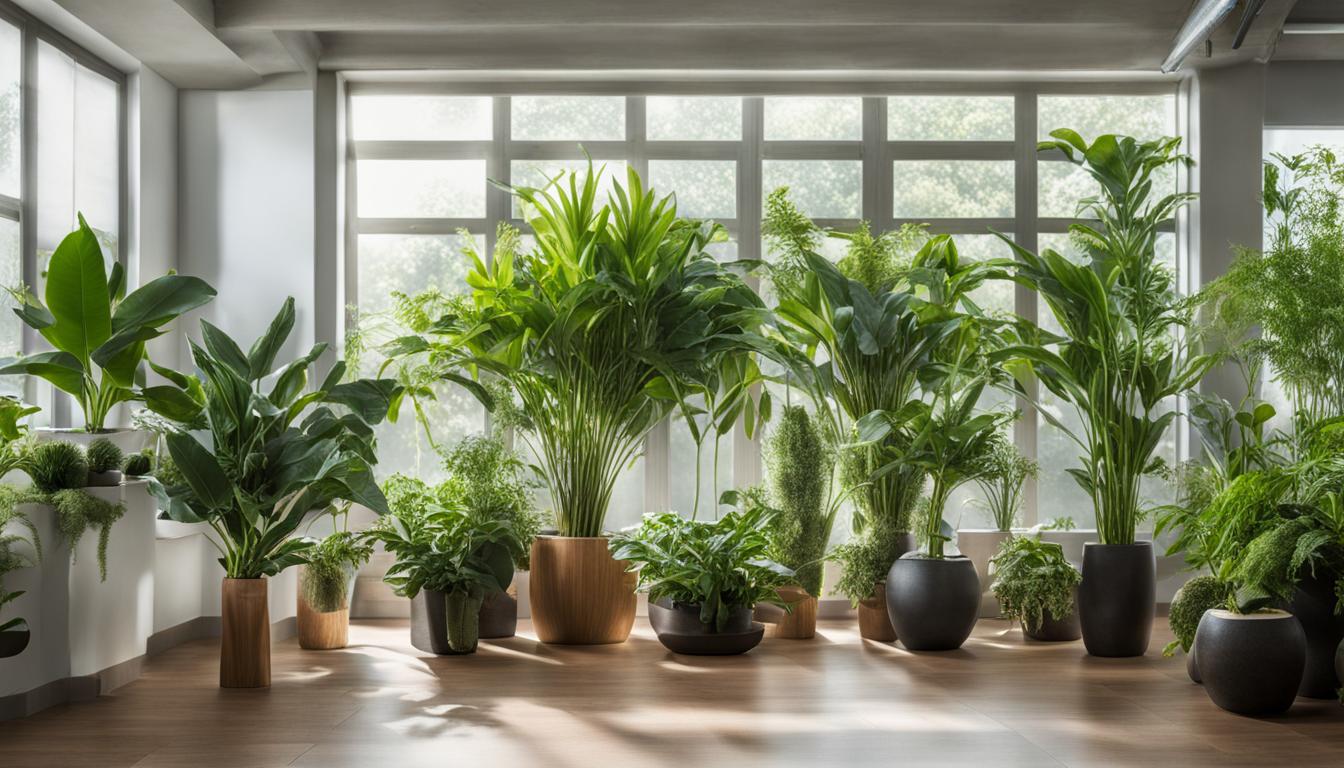
The COVID-19 pandemic has highlighted the importance of maintaining good air quality in our homes. Indoor air pollution is a concern, as it can lead to respiratory problems, allergies, and other health issues.
One natural and effective way to purify the air is by using indoor plants. Research has shown that certain plants have the ability to remove toxins and pollutants from the air, improving indoor air quality.
In this guide, we will explore how to use indoor plants for air purification and create a healthier environment in your home.
Key Takeaways:
- Indoor plants can effectively purify the air in your home and improve indoor air quality.
- They have the ability to absorb carbon dioxide and release oxygen, creating a cleaner and healthier environment.
- Certain plants can remove harmful chemicals and pollutants from the air, such as formaldehyde and volatile organic compounds (VOCs).
- To optimize the air purifying abilities of indoor plants, choose the right plants and provide proper care.
- Incorporating indoor plants into your home décor can also have additional benefits, such as reducing stress and increasing productivity.
The Benefits of Indoor Plants for Air Purification
Indoor plants offer numerous benefits when it comes to air purification. They have the ability to absorb carbon dioxide and release oxygen through photosynthesis, improving air quality.
Also, certain plants can remove harmful chemicals and pollutants from the air, such as formaldehyde, benzene, and volatile organic compounds (VOCs), which are commonly found in household products. These plants act as natural air purifiers, creating a cleaner and healthier indoor environment.
Not only do indoor plants help refresh the air, but they also contribute to a sense of tranquility and well-being. Just having plants in your environment can reduce stress levels and boost mood. They provide a connection to nature, even in an indoor setting, and create a visually appealing ambiance.
Studies have shown that indoor plants can have a positive impact on productivity and concentration. Their presence in an office or workspace can improve focus and creativity, leading to better work performance. Additionally, the greenery and natural elements provided by indoor plants can enhance overall aesthetics, making your space more inviting and enjoyable.
Benefits of Indoor Plants for Air Purification
| Benefit | Description |
|---|---|
| Improved air quality | Indoor plants absorb carbon dioxide and release oxygen, reducing pollutants in the air and creating a healthier environment. |
| Removal of harmful chemicals | Certain plants have the ability to filter out toxins and pollutants, such as formaldehyde and benzene, commonly found in household products. |
| Stress reduction | The presence of indoor plants can help reduce stress levels and promote a sense of tranquility and well-being. |
| Enhanced aesthetics | Indoor plants add natural beauty to any space, creating an inviting and visually appealing ambiance. |
| Improved productivity | Studies have shown that indoor plants can enhance focus, concentration, and overall work performance. |
Incorporating indoor plants into your home or workspace is a simple and effective way to improve air quality and create a healthier environment. Choose plants that are known for their air-purifying abilities, such as peace lilies, snake plants, and spider plants. By harnessing the natural power of these plants, you can breathe cleaner air, reduce stress, and enjoy the many benefits they offer.
Best Indoor Plants for Air Purification
When it comes to improving indoor air quality, certain indoor plants are particularly effective at purifying the air by removing toxins and pollutants. Here are some of the best indoor plants for air purification:
| Plant | Benefits |
|---|---|
| Spider Plant | The spider plant is highly efficient at removing formaldehyde, carbon monoxide, and other harmful substances from the air. It also helps to increase oxygen levels. |
| Pothos | Pothos is known for its ability to filter out formaldehyde and benzene. It is also a low-maintenance plant, making it perfect for beginners. |
| Snake Plant | The snake plant is a popular choice for air purification as it can remove toxins such as nitrogen oxide and xylene. It is also known for its ability to release oxygen at night, making it ideal for bedrooms. |
| Peace Lily | The peace lily is effective at removing common indoor pollutants, including formaldehyde, benzene, and trichloroethylene. It also adds a touch of elegance to any room. |
These indoor plants not only enhance the aesthetics of your space but also contribute to cleaner and healthier indoor air. By incorporating these plants into your home, you can create a more pleasant environment while reducing the presence of harmful substances.
It’s important to note that different plants have varying levels of air purifying capabilities, so consider the specific needs of your space when selecting indoor plants for air purification. Additionally, ensure that you provide proper care and maintenance to maximize the effectiveness of these plants in improving air quality.
How to Use Indoor Plants for Air Purification
To effectively use indoor plants for air purification, consider the following tips:
1. Choose the right plants: Not all indoor plants have the same air purifying abilities. Research and select plants that are known for their air-cleaning properties, such as snake plants, spider plants, or peace lilies. These plants have been found to effectively remove toxins and pollutants from the air.
2. Determine the number of plants: The number of plants needed to effectively purify the air in your space will depend on factors like room size and plant size. As a general rule, aim for at least one plant per 100 square feet of space. You can also create small clusters of plants for improved air purification.
3. Place plants strategically: Position your indoor plants in areas where they can have the most impact on air quality. Consider placing them near sources of indoor air pollution, such as electronics, cleaning products, or high-traffic areas. You can also distribute plants throughout your home to ensure a consistent improvement in air quality.
4. Provide proper care: Indoor plants require proper care to thrive and effectively purify the air. Follow specific care instructions for each plant, such as watering, light exposure, and humidity levels. Regularly dust the leaves to remove any buildup that could hinder their air purifying abilities. Additionally, monitor the health of your plants and address any issues promptly to maintain their effectiveness.
Creating an Indoor Plant Air Purification System
| Plant | Air Purifying Abilities | Placement |
|---|---|---|
| Snake Plant | Filters out formaldehyde, benzene, and trichloroethylene | Bedrooms and living rooms |
| Spider Plant | Removes formaldehyde and xylene | Kitchen and bathroom |
| Peace Lily | Filters out formaldehyde, benzene, and trichloroethylene | Anywhere in the house |
By following these tips and creating an indoor plant air purification system, you can effectively improve the air quality in your home. Remember to choose the right plants, place them strategically, and provide proper care to maintain their air purifying abilities. Enjoy the benefits of cleaner and healthier indoor air.
Additional Tips for Improving Indoor Air Quality
While using indoor plants for air purification is a great step towards improving indoor air quality, there are other measures you can take to further enhance the atmosphere in your home. Consider implementing these additional tips:
Proper Ventilation
Ensure that your home has proper ventilation to allow for fresh air circulation. Open windows regularly to let in natural airflow and reduce the build-up of pollutants. If your home doesn’t have good natural airflow, consider using fans or air purifiers to keep the air moving.
Regular Cleaning
Dust and allergens can accumulate on surfaces and contribute to poor indoor air quality. Regularly clean your home to remove dust, pet dander, and other particles that can affect your respiratory health. Vacuum carpets and rugs frequently, mop floors, and wipe down surfaces with non-toxic cleaning products.
Avoid Harsh Chemicals
Many household cleaning products contain chemicals that can release harmful pollutants into the air. Opt for natural and eco-friendly cleaning products to minimize the presence of toxins in your home. You can also make your own cleaning solutions using ingredients like vinegar, baking soda, and lemon juice.
Control Humidity Levels
Excess moisture in your home can lead to the growth of mold and mildew, which can negatively impact air quality. Use dehumidifiers or air conditioners to maintain optimal humidity levels between 30% to 50%. Additionally, fix any leaks or water damage promptly to prevent mold growth.
By incorporating these additional tips into your routine, you can create a healthier indoor environment and enjoy improved air quality. Remember to combine these practices with the use of air-purifying indoor plants to maximize the benefits for you and your family.
Debunking Common Myths About Indoor Plants and Air Purification
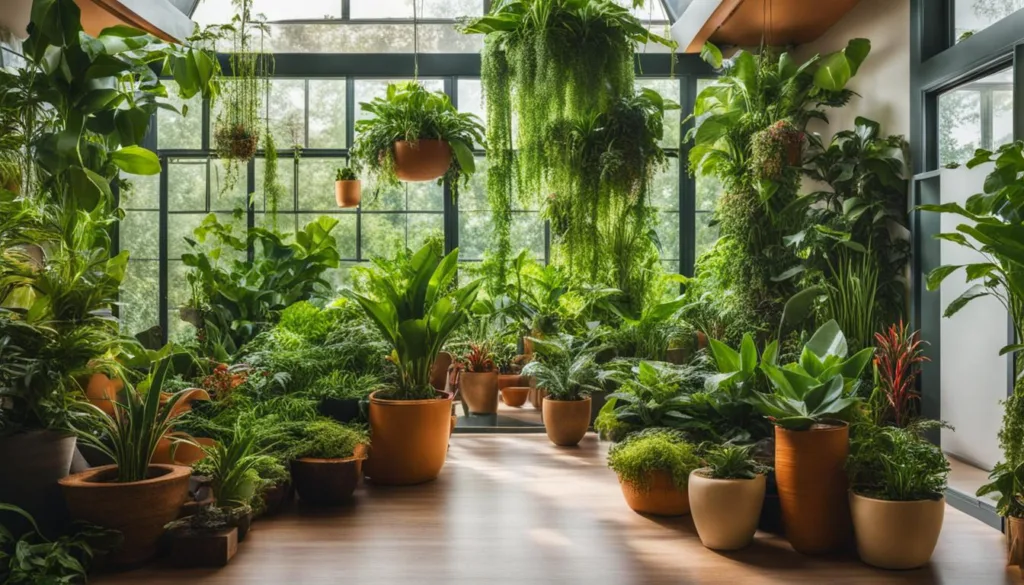
Indoor plants have gained popularity as natural air purifiers, but there are several myths surrounding their ability to improve indoor air quality. Let’s take a closer look at some of these misconceptions and debunk them:
Myth 1: Indoor plants cannot effectively remove toxins from the air.
This is simply not true. Research has shown that certain indoor plants have the ability to absorb and break down harmful pollutants such as formaldehyde, benzene, and volatile organic compounds (VOCs), which are commonly found in household products. These plants act as natural filters, purifying the air and making it healthier to breathe.
Myth 2: Indoor plants release excessive amounts of moisture, leading to mold growth.
While it is true that plants release some moisture through a process called transpiration, the amount is minimal and unlikely to contribute to mold growth if proper ventilation is maintained. In fact, some studies suggest that indoor plants can help regulate humidity levels by releasing moisture when the air is dry and absorbing it when the air is humid.
Myth 3: Indoor plants require a lot of maintenance and can be difficult to care for.
While it’s true that some indoor plants may require specific care instructions, many varieties are low-maintenance and require minimal attention.
There are plenty of indoor plants, such as snake plants, pothos, and spider plants, that are known for their ability to thrive in various indoor environments with minimal care. With the right selection and proper care, anyone can enjoy the benefits of indoor plants without feeling overwhelmed.
Debunking these myths helps us understand the true potential of indoor plants in improving indoor air quality. By incorporating air purifying indoor plants into our homes, we can create a healthier environment for ourselves and our loved ones.
Common Misconceptions About Indoor Plants and Air Purification
| Myth | Debunked |
|---|---|
| Indoor plants cannot effectively remove toxins from the air. | Research has shown that certain indoor plants have the ability to absorb and break down harmful pollutants, improving indoor air quality. |
| Indoor plants release excessive moisture, leading to mold growth. | The amount of moisture released by indoor plants is minimal and not likely to contribute to mold growth if proper ventilation is maintained. |
| Indoor plants require a lot of maintenance and can be difficult to care for. | While some indoor plants may require specific care instructions, many varieties are low-maintenance and easy to care for. |
Creating a Healthy Indoor Environment with Indoor Plants
Incorporating indoor plants into your home decor not only improves air quality but also creates a healthy and relaxing indoor environment. Indoor plants have been scientifically proven to enhance our well-being and provide numerous benefits beyond air purification. Here are some additional advantages of using indoor plants to create a healthier indoor space.
Reduced Stress and Increased Productivity
Indoor plants have a calming effect on our minds and can help reduce stress levels. Studies have shown that the presence of plants in our environment can lower blood pressure, heart rate, and anxiety levels. By creating a green oasis in your home with indoor plants, you can create a soothing atmosphere that promotes relaxation and tranquility.
Additionally, indoor plants have been found to enhance productivity and concentration. The visual appeal of plants stimulates our senses and improves our mood, making us more focused and attentive. Whether you place a few plants on your desk or create a lush indoor garden, incorporating indoor plants into your workspace can boost your productivity and creativity.
Aesthetically Pleasing Indoor Space
Indoor plants add a touch of natural beauty to any indoor space. They come in a variety of shapes, sizes, and colors, allowing you to choose plants that complement your existing decor and personal style.
From vibrant flowers to lush foliage, indoor plants can transform your home into a visually appealing sanctuary. By selecting plants that thrive in different light conditions, you can create interesting focal points and add depth to your interior design.
Moreover, indoor plants can serve as statement pieces and conversation starters. Whether you opt for a tall, sculptural plant or a hanging vine, these living decorations can become the center of attention in any room. Embrace the versatility of indoor plants and let them become an integral part of your home’s aesthetic.
Remember to choose indoor plants that align with your lifestyle and space requirements. Consider factors such as light levels, temperature, and humidity when selecting the right plants for each room.
With proper care and maintenance, indoor plants will not only enhance your indoor air quality but also contribute to a healthier and more inviting living environment.
Maintaining Indoor Plants for Air Purification
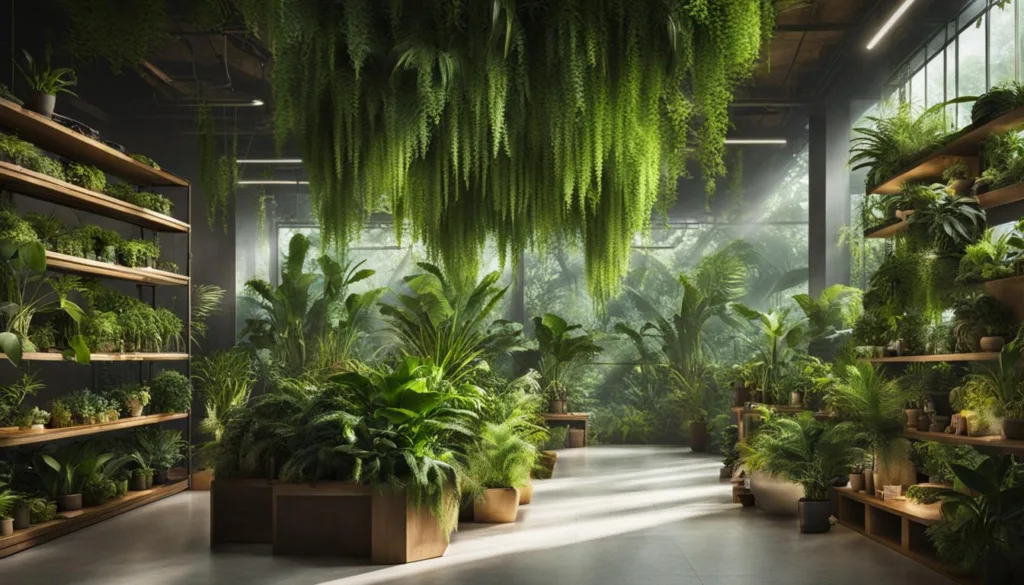
Proper maintenance is crucial to ensure the effectiveness of indoor plants in purifying the air and keeping them thriving. By following these tips, you can create a healthy and vibrant environment in your home:
- Watering: Different indoor plants have varying water requirements. Be sure to research the specific watering needs of each plant and adjust accordingly. Avoid overwatering, as it can lead to root rot, while underwatering can cause wilting and stunted growth.
- Light and Temperature: Most indoor plants thrive in bright, indirect light. Place them near windows or areas with sufficient natural light. Avoid exposing them to direct sunlight, as it can scorch the leaves. Additionally, maintain an appropriate temperature range for your plants, as drastic fluctuations can negatively impact their health.
- Fertilizing: Indoor plants benefit from regular fertilization to provide essential nutrients. Use a balanced, water-soluble fertilizer according to the recommended dosage and frequency specified for each plant species. Avoid overfertilizing, as it can lead to nutrient burn and damage the plant’s roots.
- Pest Control: Keep a close eye on your indoor plants for any signs of pests, such as aphids, mealybugs, or spider mites. If detected, promptly address the issue using environmentally-friendly pest control methods, such as insecticidal soap or neem oil.
- Grooming: Regularly remove dead or yellowing leaves, as they can attract pests and hinder healthy growth. Prune your plants to maintain their desired shape and promote bushier growth.
By implementing these maintenance practices, you can ensure that your indoor plants continue to purify the air and add beauty to your home.
Maintenance Tips for Common Indoor Plants
| Plant | Watering | Light | Temperature | Fertilizing | Pest Control | Grooming |
|---|---|---|---|---|---|---|
| Snake Plant | Allow soil to dry between watering | Low to bright indirect light | 60-85°F (15-29°C) | Every 2-3 months | Minimal pest issues | Remove dead leaves |
| Spider Plant | Keep soil lightly moist | Bright, indirect light | 60-75°F (15-24°C) | Every 2-4 weeks | Occasional spider mites | Remove yellowing leaves |
| Peace Lily | Keep soil evenly moist | Medium to low indirect light | 65-85°F (18-29°C) | Every 6-8 weeks | Susceptible to aphids and mealybugs | Trim spent flowers and yellow leaves |
| Devil’s Ivy | Allow soil to dry slightly between watering | Low to bright indirect light | 60-85°F (15-29°C) | Every 2-4 weeks | Resistant to most pests | Trim long stems and yellow leaves |
Remember to always consult specific care guidelines for each individual plant species to ensure their optimal health and air purifying capabilities.
Indoor plants are a great addition to any home looking to improve indoor air quality. By using indoor plants for air purification, you can create a healthier environment for you and your family. These plants have the ability to remove toxins and pollutants from the air, making it cleaner and fresher to breathe.
While indoor plants alone may not be the sole solution to air pollution, they can complement other measures you take to enhance air quality. By choosing the right plants, creating a green oasis, and providing proper care, you can optimize their air purifying abilities.
Not only do indoor plants improve air quality, but they also offer additional benefits such as reduced stress, increased productivity, and a visually appealing indoor space. So, start using indoor plants for air purification today and enjoy the benefits of better air in your home.
FAQ
Are indoor plants effective at purifying the air in our homes?
Yes, indoor plants have the ability to remove toxins and pollutants from the air, improving indoor air quality.
What benefits do indoor plants offer for air purification?
Indoor plants can absorb carbon dioxide and release oxygen, as well as remove harmful chemicals and pollutants from the air.
Which indoor plants are best for air purification?
Some of the best indoor plants for air purification include peace lilies, snake plants, spider plants, and pothos.
How should I use indoor plants for air purification?
Place indoor plants strategically throughout your home, especially in areas with poor ventilation or high levels of pollutants.
What else can I do to improve indoor air quality?
In addition to using indoor plants, you can reduce chemical use, keep your home clean, and ensure proper ventilation.
Are there any misconceptions about indoor plants and air purification?
Yes, some common myths include the idea that all indoor plants purify the air equally or that they can eliminate all pollutants.
What other benefits do indoor plants provide besides air purification?
Indoor plants can reduce stress, increase productivity, and enhance the visual appeal of your indoor space.
How do I properly maintain indoor plants for air purification?
Proper maintenance includes providing adequate sunlight, watering, and occasionally cleaning the leaves of your indoor plants.

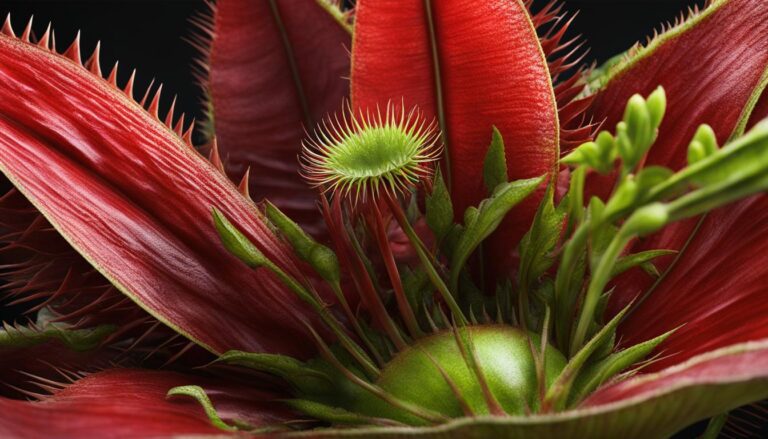
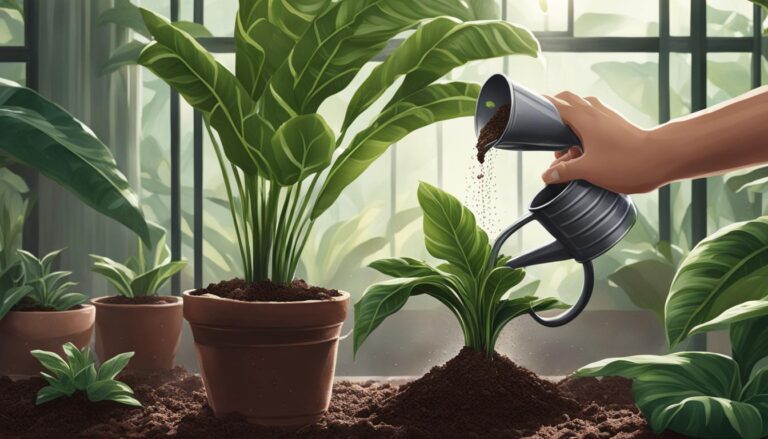

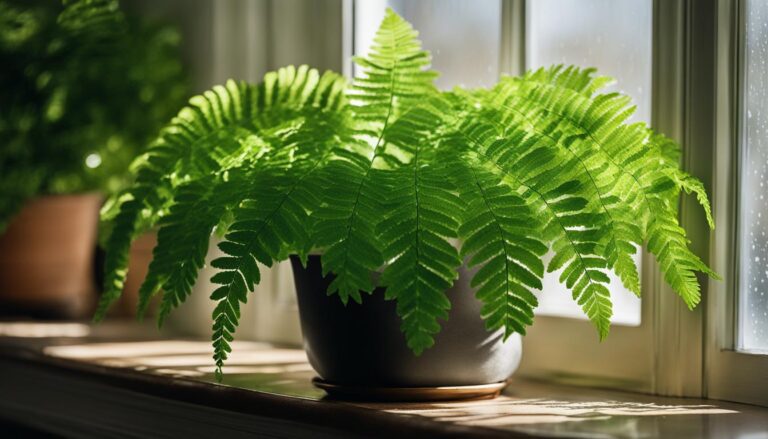
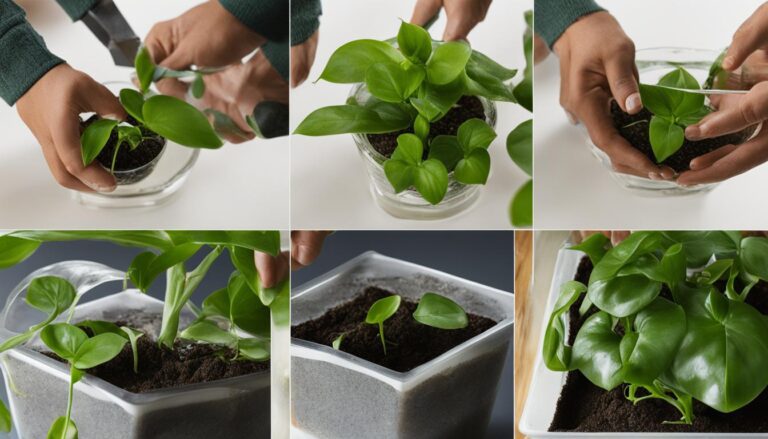
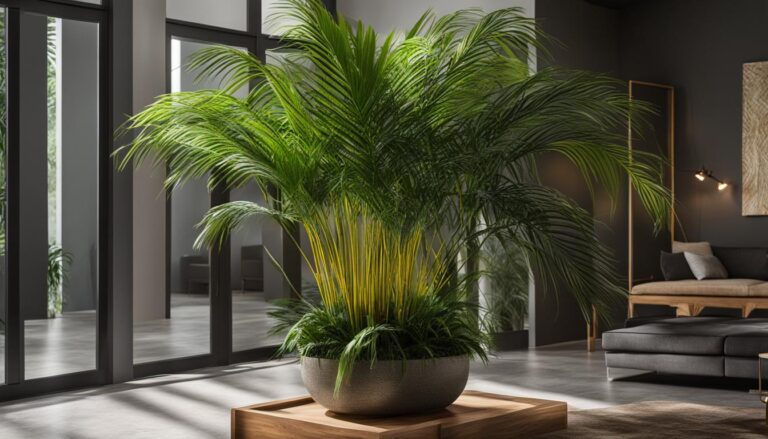
2 Comments
Comments are closed.